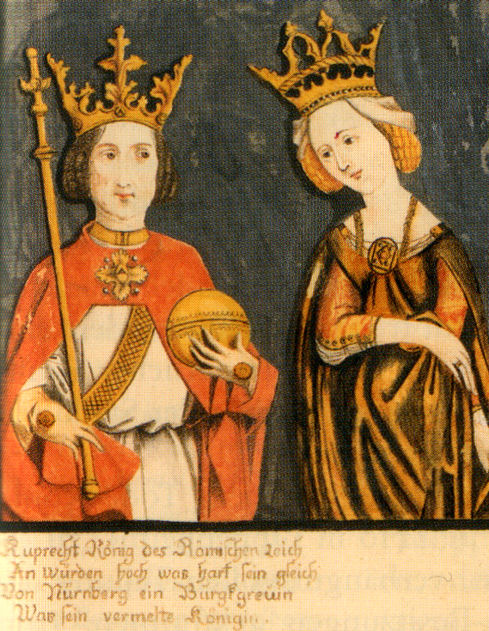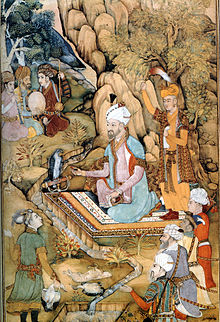Well-Behaved Women Rarely Make History: Eleanor of Aquitaine’s Political Career and Its Significance to Noblewomen
Eleanor of Aquitaine played an indirect role in the formation of medieval and early modern Europe through her resources, wit, and royal connections.
A Royal Gift Exchange
Natalie Anderson explores the gifts exchanged between two powerful medieval monarchs: King Henry VIII of England and Holy Roman Emperor Maximilian I.
The Medieval Monarchy’s Symbols of Power
Even if a king was born into his position, he still needed to maintain that standing among his nobility and his royal peers and that maintenance was through the use of certain symbols and objects.
The Global Side of Medieval at the Getty Centre: Traversing the Globe Through Illuminated Manuscripts
Los Angeles correspondent, Danielle Trynoski takes through the, ‘Traversing the Globe Through Illuminated Manuscripts’ exhibut at the Getty Museum.
Rose without Thorn, Eagle without Feathers: Nation and Power in Late Medieval England and Germany
It is hard at times to take the Agincourt Carol entirely seriously. Patriotism of such brash exuberance seems more properly to belong in a brightly lit Laurence Olivier world of mid twentieth-century medievalism than amid the grim and tangled realities of fifteenth- century politics and war.
Competition and tradition: Carolingian political rituals, 751-800
In 751, the Carolingians supplanted the traditional ruling dynasty of Francia. This article surveys Carolingian political rituals between 751 and 800, and argues that ritual was one means through which this new royal family sought to construct and legitimate its authority against its dynastic competitors.
The Journey of Charles I, King of Hungary, from Visegrád to Naples (1333): Its Political Implications and Artistic Consequences
The aim of this article is to reconstruct the journey of Charles I, King of Hungary (1310– 1342), from Visegrád to Naples in the year 1333.
Making a difference in tenth-century politics: King Athelstan’s sisters and Frankish queenship
In the early years of the tenth century several Anglo-Saxon royal women, all daughters of King Edward the Elder of Wessex (899-924) and sisters (or half-sisters) of his son King Athelstan (924-39), were despatched across the Channel as brides for Frankish and Saxon rulers and aristocrats. This article addresses the fate of some of these women through an analysis of their political identities.
BOOKS: Great Reads about Medieval Queens!
Queens Consort: England’s Medieval Queens from Eleanor of Aquitaine to Elizabeth of York Author: Lisa Hilton Publisher: Pegasus (August 3, 2010) Summary England’s medieval…
Kings, Conquerors, and Gods: The Autobiographies of Timur, Isma’il, and Babur
In 1360, a hundred years after the finalization of Mongol conquest, the most famous of these post-Genghisid rulers emerged in Kesh, not far from Samarqand. Timur Barlas, anglicized as Tamerlane, pursued a life-long career of warfare, first establishing himself in the ranks of the regional amir Kurgen and eventually awing the entire region from the Punjab to Cairo and Constantinople through his conquests. Like his predecessor Genghis, Timur has since been a hotly debated figure.
‘Kings were not wont to render account’ Henry IV and the Authority of the King
Henry travelled extensively, became famed throughout Christendom as a champion jouster, crusaded in Eastern Europe, and looked after his father’s holdings whilst John of Gaunt campaigned in Spain.3 It is impossible not to note that Henry Bolingbroke’s popularity continued to increase while Richard II’s declined.
The Symbolic Meaning of Sword and Palio in Late Medieval and Early Modern Ritual Entries: The Case of Seville
If I have spend some time establishing the semantic field in which these terms appear, it is because I wish to emphasize the malleability of concepts such as symbols and rituals, particularly when applied to the articulation of powers Moreover, these meanings and intents depend often on the context, temporal and geographical location.
The Morosinis in Hungary under King Andrew III and the two versions of the death of the Queen of Hungary Tommasina
In reality, Charles Robert’s predecessor, the last Arpád, Andrew III, called the Vene- tian, was already a foreigner on the throne of Hungary.
The Dominican Convents in Medieval Norway
In the Middle Ages, the Kingdom of Norway was larger than it is today, where the former Norwegian districts of Jämtland and Bohus are now parts of Sweden. In 1380, the Norwegian throne was inherited by the Danish king, and for the rest of the Middle Ages, Danish monarchs ruled Norway, but even though the kings often made use of Danes in the administration, the Norwegian kingdom did in fact remain as an independent part of a so-called double monarchy.
The Swedish Kings in Progress – and the Centre of Power
Why did the rulers travel! One reason was purely financial: the economy demanded a constant movement of the household. Once the food supplies in one place of abode had been eaten up it was easier to move to a new residence than to transport provisions overlong distances. Mobility contributed to the proper utilization of the produce of manors.
Transylvanian Identities in the Middle Ages
Identity has become a subject of historical exploration as it is also one of the themes examined from the perspectives of various disciplines belonging to the social sciences such as sociology, psychology or anthropology.
“Kings as Catechumens: Royal Conversion Narratives and Easter in the Historia Ecclesiastica” by Carolyn Twomey (Boston College)
This is the first paper from the Haskins Conference at Boston College – it focused on Bede’s narratives of Royal conversion.
“The Softness of Her Sex”: Matilda’s Role in the English Civil War of 1138-1153
This thesis examines the life of the Empress Matilda (1102-1167), focusing on how factors beyond her control directed much of its course. It discusses her attempts to take control of the political realm in England and the effect this had on her, her supporters, and her kingdom. It also analyzes her later years and influence on her son Henry II.
The King’s Mercy. An Attribute of Later Medieval English Monarchy
Modern assumptions about medieval justice still tend to see this process of amelioration as merely occasional and exceptional: mercy needed to be applied only where special circumstances made it inappropriate to apply the full rigours of the law. This, however, is seriously to misunderstand both the purpose and the pervasiveness of mercy in the operation of medieval justice.
King Pedro IV of Aragon, royal propaganda and the tradition of royal speechwriting
In the archives of the Crown of Aragon in Barcelona is preserved the autograph manuscript of a speech against the rebellion of the Judge of Arborea in Sardinia made by King Pedro IV of Aragon to open the corts, probably that held in Sant Mateu, Valencia in 1369.
Portuguese Crypto-Jewish Ballads: A Passagem do Mar Vermelho and A Pedra Mara
Some New Christians managed to escape abroad, founding Jewish communities in Bordeaux, London, Amsterdam, and other cities (Azevedo 359-430). With the union of the Portuguese and Spanish crowns (1580-1640), the number of those who moved to Spain and its American colonies was so great that the word “Portuguese” became practically synonymous with “Jew.”



















